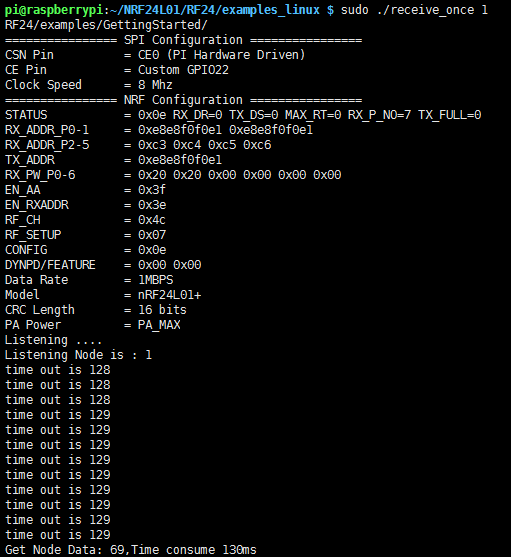考虑到项目的实际需要,树莓派作为主机,应该只在需要的时候查询特定节点发送的数据,因此接收到数据后需要根据头部判断是否是自己需要的数据,如果不是继续接收数据,超过一定时间未查询到特定节点的数据,则退出程序,避免无限等待。
本项目中各个节点和树莓派的通信不区分信道,因此如果由树莓派发送给特定节点的数据会被所有节点接收到,因此子节点可以判别该数据是否发给自己的,需要在数据的第二个字节中加入目标节点的编号(第一个字节为源节点的编号)。
树莓派代码
如下:
#include <cstdlib> #include <iostream> #include <sstream> #include <string> #include <unistd.h> #include <RF24/RF24.h> using namespace std; RF24 radio(22,0,BCM2835_SPI_SPEED_8MHZ); /********** User Config *********/ // Assign a unique identifier for this node, 0 or 1 bool radioNumber = 1; bool role = 0;//receive mode unsigned long start_time=millis(); unsigned long count=0; /********************************/ // Radio pipe addresses for the 2 nodes to communicate. const uint64_t pipes = 0xE8E8F0F0E1LL; unsigned long receData; unsigned long respData=0x01; unsigned long srchead=0x00000000; int main(int argc, char** argv){ cout << "RF24/examples/GettingStarted/ "; // Setup and configure rf radio radio.begin(); // optionally, increase the delay between retries & # of retries radio.setRetries(15,15); // Dump the configuration of the rf unit for debugging radio.printDetails(); radio.openReadingPipe(1,pipes); /***********************************/ // This simple sketch opens two pipes for these two nodes to communicate // back and forth. radio.startListening(); cout << "Listening .... "; int node = atoi(argv[1]); cout << "Listening Node is : " <<node<<" "; while(1){ unsigned long end_time = millis(); if(radio.available()){ radio.read(&receData,sizeof(unsigned long)); //cout<<"receData is: "<<receData<<" "; unsigned int check = (unsigned int) receData>>24; unsigned long data = receData & 0x0000ffff; //cout<<"check is "<<check<<" ";
if(check==node && (receData & 0x00ff0000)==srchead){ cout<<"Get Node Data: "<<data<<",Time consume "<<(end_time-start_time)<<"ms "; break; } } cout<<"time out is "<<(end_time-start_time)<<" "; if((end_time-start_time)>=5000){ cout<<"Wait Data from Node "<<node<<" time out "; break; } } return 0; }
输入指令:sudo ./receive_once 1,参数1表示要查询的节点节点。得到以下结果:

Arduino Leonardo代码
Arduino Leonardo作为子节点,代码与前一节一样,不停发送和接收相互切换。如下:
#include <SPI.h> #include "RF24.h" #include <SPI.h> #include "RF24.h" #include <printf.h> /****************** User Config ***************************/ /*** Set this radio as radio number 0 or 1 ***/ bool radioNumber = 0; /* Hardware configuration: Set up nRF24L01 radio on SPI bus plus pins 7 & 8 */ RF24 radio(9,10); /**********************************************************/ byte addresses[][6] = {"1Node","2Node"}; // Used to control whether this node is sending or receiving bool role = 1;//1表示发送模式,0表示接收模式 unsigned long start_time = millis(); //这个是我们即将建立的传输渠道编码 //!!要和另一个模块的一致 const uint64_t pipes = 0xE8E8F0F0E1LL; //这个变量会保持我们接受到的信息 //变量类型一定要和传过来的一样 //要传输的数据 unsigned long sendData = 1; unsigned long srchead = 0x01000000;//高16位为头标志,前8位为源节点,后8位为目的节点。根据标志不同区分不同发送源,00为中心主节点 unsigned long deshead = 0x00000000;//高16位为头标志,前8位为源节点,后8位为目的节点。根据标志不同区分不同发送源,00为中心主节点 unsigned long receData; void setup() { pinMode(13,OUTPUT);//指示灯 Serial.begin(57600); printf_begin(); Serial.println(F("RF24/examples/GettingStarted")); radio.begin(); radio.setPALevel(RF24_PA_MAX); radio.openWritingPipe(pipes); } void loop() { Serial.print("role:"); Serial.println(role); if(role){ unsigned long data = sendData+srchead+deshead; Serial.print("Sending:"); Serial.println(data); digitalWrite(13,HIGH); bool ok = radio.write(&data,sizeof(unsigned long)); role = 0; radio.startListening();
radio.openReadingPipe(1,pipes); start_time = millis(); } if(!role){ digitalWrite(13,LOW); if(radio.available()){ radio.read(&receData,sizeof(unsigned long)); //根据目标节点,判断是否是发给自己的,如果是,执行相关操作 unsigned long check = receData & 0x00ff0000; if(check == srchead){ //接收到来自主机的数据,执行相关操作 Serial.print("Response:"); Serial.println(receData); } role = 1; radio.stopListening();
radio.openWritingPipe(pipes); }else{ unsigned long end_time = millis(); if((end_time-start_time)>=100){ role = 1; radio.stopListening();
radio.openWritingPipe(pipes); } } } } // Loop